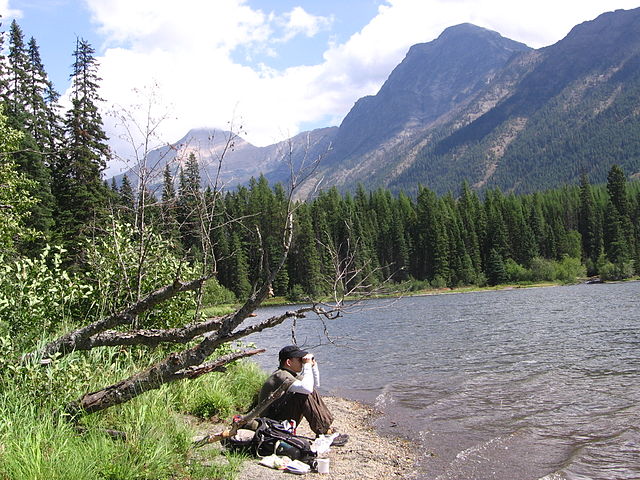One of the questions asked by participants in citizen science programs is, “How useful are the data that I’m collecting?” Well, if you were the only person participating in the project, the honest answer would be, “Not very useful at all“. But one of the benefits of a citizen science project is that there are many participants, spread over a large geographic area. It is the combination of all the data from each participant within a single database that endows your data with immense scientific power.
A good example of this is the Christmas Bird Count (CBC). For many years, thousands of people have celebrated the winter and Christmas season by participating in the CBC, submitting their bird survey data to a local compiler who then forwarded the collected data to the National Audubon Society, an organization which has long maintained a database of all CBC data.
One enterprising scientist, Terry Root (who is now a Senior Fellow at Stanford University), waded deep into the CBC database and started to analyze what the information was saying about the distribution of birds in North America during the winter. She did this work as her doctoral research dissertation. The end result was the publication of a book in 1988, the “Atlas of Wintering North American Birds: An Analysis of Christmas Bird Count Data“.
Without the efforts of many people across the continent for an extended period of time, producing that book would have been very difficult if not impossible. But the combined efforts of a single citizen science project aided immensely in the advance of our understanding of one aspect of the life history of birds in North America.
What else has citizen science accomplished? To describe all of the instances where citizen science has had an impact would be well beyond the scope of this article. But here is a list of scientific publications, taken from a catalogue of such publications maintained by the Cornell University Laboratory of Ornithology, which illustrates the breadth of accomplishments of citizen science over the past 15 years.
Effects of recreational development on forest-breeding birds in US National Forests. Rosenberg, K. V., B. Kott, R. S. Hames, R. W. Rohrbaugh, Jr., S. Barker Swarthout, J. D. Lowe. Final report to USDA Forest Service.
A land manager’s guide to improving habitat for forest thrushes. Rosenberg, K. V., R. S. Hames, R. W. Rohrbaugh, Jr., S. Barker Swarthout, J. D. Lowe, and A. A. Dhondt. The Cornell Lab of Ornithology.
Adverse effects of acid rain on the distribution of the Wood Thrush Hylocichla mustelina in North America. Hames, R. S., K. V. Rosenberg, J. D. Lowe, S. E. Barker and A. A. Dhondt Proceedings of the National Academy of Sciences.
Do feeder counts reliably indicate bird population changes? 21 years of winter bird counts in Ontario, Canada. D. Lepage and C. M. Francis. Condor 104: 255-270.
Effects of forest fragmentation on tanager and thrush species in eastern and western North America. Hames, R. S., K. V. Rosenberg, J. D. Lowe, S. E. Barker, and A. A. Dhondt. Pages 81-91 in The Effects of Habitat Fragmentation on Birds in Western Landscapes: Contrasts with Paradigms from the Eastern United States. (L. George and D. S. Dobkins, Eds.). Studies in Avian Biology, No. 25., Cooper Ornithological Society, Seattle.
Geographic differences in seasonal clutch size variation in multi-brooded bird species. Dhondt, A. A., T. L. Kast, and P. E. Allen. Ibis 144: 646-651.
Host range and dynamics of mycoplasmal conjunctivitis among birds in North America. B. K. Hartup, A. A. Dhondt, K. Sydenstricker, W. M. Hochachka, and G. V. Kollias. Journal of Wildlife Disease 37(1):72-81.
An atlas of Cerulean Warbler populations. Rosenberg, K. V. and S. E. Barker. Final Report to United States Fish and Wildlife Service: 1997-2000 Breeding Seasons.
Density dependent decline of host abundance resulting from a new infectious disease. W. M. Hochachka and A. A. Dhondt. Proceedings of the National Academy of Sciences of the USA. 97(10):5303-5306.
Thinking scientifically during participation in a citizen-science project. D. Trumbull, R. Bonney, D. Bascom, and A. Cabral. Science Education. 84:265-275.
A land manager’s guide to improving habitat for Scarlet Tanagers and other forest-interior birds. Rosenberg, K. V., R. W. Rohrbaugh, Jr., S. E. Barker, J. D. Lowe, R. S. Hames, and A. A. Dhondt. The Cornell Lab of Ornithology.
Irruptive migration of Common Redpolls. W. Hochachka, J. V. Wells, K. V. Rosenberg, D. L. Tessaglia-Hymes, and A. A. Dhondt. Condor 101(2):195-204.
Feeder counts as indicators of spatial and temporal variation in winter abundance of resident birds. J. V. Wells, K. V. Rosenberg, E. H. Dunn, D. L. Tessaglia, and A. A. Dhondt. Journal of Field Ornithology 69(4):577-586.
FeederWatch: An example of a student-scientist partnership. R. Bonney and A. A. Dhondt. Chapter 3 In: Internet Links for Science Education: Student-Science Partnerships. Karen C. Cohen, ed. Plenum Press, New York.
Population status and conservation of Cerulean Warblers in the northeast. Rosenberg, K. V., S. E. Barker, J. W. Fitzpatrick. Interim Report to US Fish and Wildlife Service.
Population cycles in the Varied Thrush (Ixoreus naevius). J. V. Wells, K. V. Rosenberg, D. L. Tessaglia, and A. A. Dhondt. Canadian Journal of Zoology 74:2062-2069.
Predation of birds at feeders in winter. E. H. Dunn and D. L. Tessaglia. Journal of Field Ornithology 65(1):8-16.
Bird mortality from striking residential windows in winter. E. H. Dunn. Journal of Field Ornithology 64(3):302-309.

